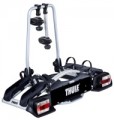Load capacity
The maximum weight that is allowed to be carried on the boot.
It is definitely not worth exceeding this parameter — even if the structure does not break immediately, this can happen at any time due to off-design loads. And ideally, you should have some margin for carrying capacity — this will give an additional guarantee in case of emergency situations (like hitting a wheel in a hole at speed).
Also note that the weight of the intended load must be supported not only by the boot itself, but also by the crossbars on which it is installed (if this installation option is used, see above). Moreover, the weight of both the cargo and the boot falls on the crossbars, which requires an even greater margin for load for them.
As for specific carrying capacity indicators, in general, the indicator
up to 50 kg is considered relatively low,
51 – 75 kg — average,
76 – 100 kg — above average, and in the most "heavy" models, the permissible load weight
exceeds 100 kg.
Number of bike
The number of bikes that the dedicated carrier is designed for (see "Type").
For each bike in such mounts, a seat is provided, so the number of bicycles transported is strictly limited. Note that roof racks (on roof rails, crossbars, etc. — see "Installation") are usually designed for only
1 bike, but in rear-mounted models (on the back door, tow bar, etc.) .) there are solutions for
2 places and even
more.
Weight
Net weight of the boot in working (fully assembled) form.
The light weight contributes to fuel economy (especially during long-term use) and also makes it easier to transport the boot outside the car (for example, from storage to the car and back). On the other hand, lightening the product leads either to a decrease in its strength and load capacity, or to an increase in cost. So in certain situations, a relatively heavy boot may be the best choice; and when choosing a light model, you should pay special attention to the claimed load capacity.

